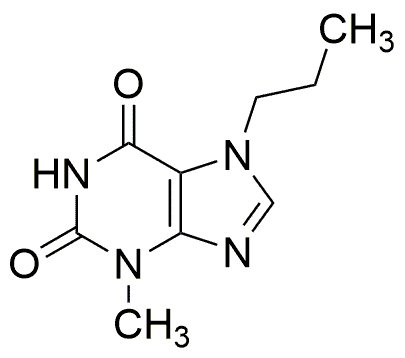3-Methyl-7-propylxanthine is widely utilized in research focused on:
- Pharmaceutical Development: This compound serves as a key intermediate in the synthesis of various pharmaceuticals, particularly those targeting the central nervous system, offering potential treatments for conditions like asthma and ADHD.
- Research on Caffeine Derivatives: It is studied for its structural similarities to caffeine, helping researchers understand the effects of methylxanthines on human health and metabolism, which can lead to the development of new dietary supplements.
- Agricultural Applications: The compound is explored for its potential use as a plant growth regulator, enhancing crop yield and resistance to environmental stress, which is crucial for sustainable agriculture.
- Biochemical Studies: It is employed in studies investigating the role of xanthines in cellular signaling pathways, aiding in the understanding of various diseases and cellular processes.
- Food and Beverage Industry: This chemical is being researched for its potential use in formulating energy drinks and functional foods, providing a natural stimulant effect that can enhance physical performance.
General Information
Properties
Safety and Regulations
Applications
3-Methyl-7-propylxanthine is widely utilized in research focused on:
- Pharmaceutical Development: This compound serves as a key intermediate in the synthesis of various pharmaceuticals, particularly those targeting the central nervous system, offering potential treatments for conditions like asthma and ADHD.
- Research on Caffeine Derivatives: It is studied for its structural similarities to caffeine, helping researchers understand the effects of methylxanthines on human health and metabolism, which can lead to the development of new dietary supplements.
- Agricultural Applications: The compound is explored for its potential use as a plant growth regulator, enhancing crop yield and resistance to environmental stress, which is crucial for sustainable agriculture.
- Biochemical Studies: It is employed in studies investigating the role of xanthines in cellular signaling pathways, aiding in the understanding of various diseases and cellular processes.
- Food and Beverage Industry: This chemical is being researched for its potential use in formulating energy drinks and functional foods, providing a natural stimulant effect that can enhance physical performance.
Documents
Safety Data Sheets (SDS)
The SDS provides comprehensive safety information on handling, storage, and disposal of the product.
Product Specification (PS)
The PS provides a comprehensive breakdown of the product’s properties, including chemical composition, physical state, purity, and storage requirements. It also details acceptable quality ranges and the product's intended applications.
Certificates of Analysis (COA)
Search for Certificates of Analysis (COA) by entering the products Lot Number. Lot and Batch Numbers can be found on a product’s label following the words ‘Lot’ or ‘Batch’.
*Catalog Number
*Lot Number
Certificates Of Origin (COO)
This COO confirms the country where the product was manufactured, and also details the materials and components used in it and whether it is derived from natural, synthetic, or other specific sources. This certificate may be required for customs, trade, and regulatory compliance.
*Catalog Number
*Lot Number
Safety Data Sheets (SDS)
The SDS provides comprehensive safety information on handling, storage, and disposal of the product.
DownloadProduct Specification (PS)
The PS provides a comprehensive breakdown of the product’s properties, including chemical composition, physical state, purity, and storage requirements. It also details acceptable quality ranges and the product's intended applications.
DownloadCertificates of Analysis (COA)
Search for Certificates of Analysis (COA) by entering the products Lot Number. Lot and Batch Numbers can be found on a product’s label following the words ‘Lot’ or ‘Batch’.
*Catalog Number
*Lot Number
Certificates Of Origin (COO)
This COO confirms the country where the product was manufactured, and also details the materials and components used in it and whether it is derived from natural, synthetic, or other specific sources. This certificate may be required for customs, trade, and regulatory compliance.


